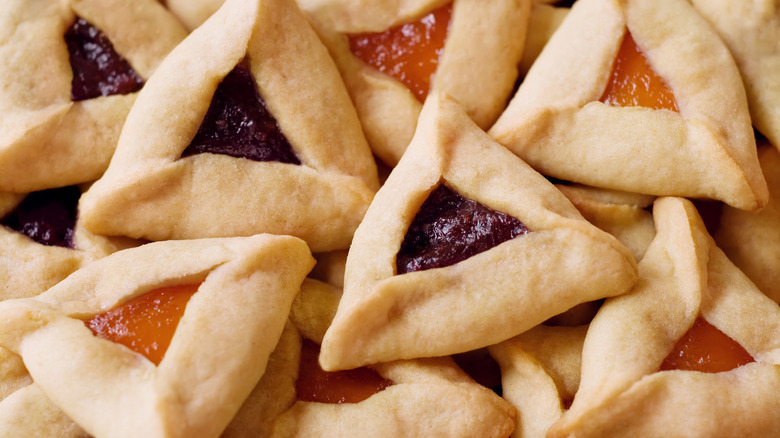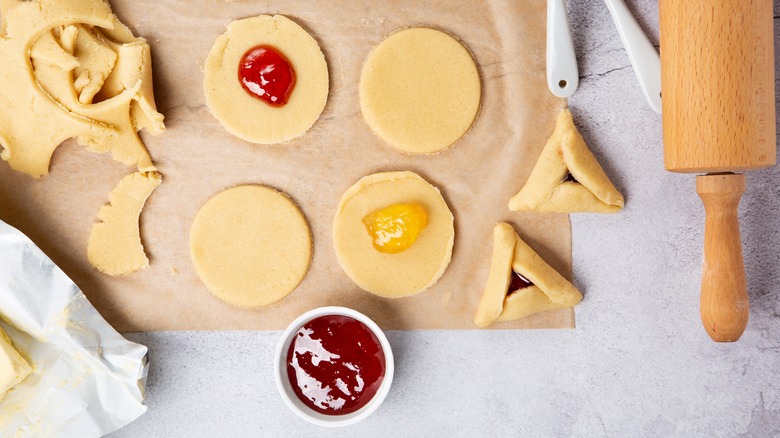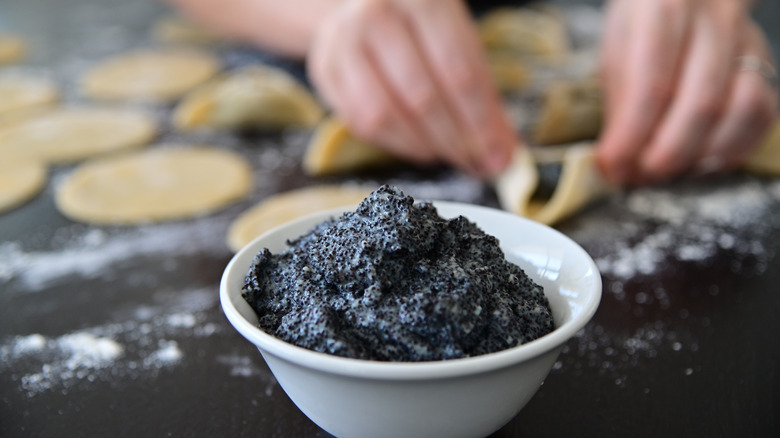The Easy Egg Swap For Tender Purim Hamantaschen
In addition to retelling the story of Queen Esther, many Purim celebrants nosh on hamantaschen. The name of the triangular cookies translates to "Haman's pockets," after the story's villain Haman — although other explanations for the symbolic treat abound and many mistakenly attribute the shape to his tri-cornered hat.
Stuffed to the brim with different spreads, the treats vary in texture and sweetness depending on the baker. The dough toes the line between sugar cookie and shortbread — yes, there is a difference that sets shortbread apart from other doughs — and the annual bake is an opportunity to make your best batch ever (if you can remember which recipe you used last year). Before getting too far into the baking process, we have a quick tip for tender pastry: Use egg yolks.
We recommend starting with one yolk in place of the usual egg before adding a second if need be. The resulting tender cookie may have a cakier texture or become slightly crumbly with the adjustment. The goal is to avoid a tough dough while adding a delicious note of richness. Since the yolk acts as a natural emulsifier, the dough will become creamy without needing dairy — perfect if you want to keep these parve. The hamantaschen may be a little chewier than you're used to, and the dough can be a touch trickier to work with, but that rich taste and chewy crumb can't be beaten.
Other additions for a tender dough
Many recipes also call on the citrusy flair of orange zest or the added moisture of a spoonful of orange juice to flavor the sweet dough. Though less acidic than vinegar or lemon, the tart fruit may add another slight tenderizing power. Even better, it's certain to complement the sweet fillings and make for a more exciting bite.
Another approach to creating a delicate dough is tweaking the dry ingredients. Almond flour and powdered sugar both tenderize and add moisture. You can swap out some of the all-purpose for the ground nuts, or use powdered sugar in place of granulated, scaling down the amount slightly. The almonds also bring out the complexity of spiced fruit and chocolate fillings for a more sophisticated taste.
As with other tender pastries, the dough gets a long rest in the fridge to ensure it holds its shape before it's rolled out, stamped into circles, and pinched into triangles. Kosher cooks, who do not mix milk and meat, sometimes forgo butter to ensure their treats work with any meal. In that case, they might skip the chilling stage and have a different texture but still benefit from adding a rich yolk.
Classic and creative hamantaschen fillings
Though poppy seed remains one of the favored fillings, the usual apricot, prune, raspberry, and chocolate draw their own defenders. Many busy bakers opt for canned cake and pastry filling, which is slightly thicker than spreadable jams, but there's no time like the present to prepare yours from scratch. You can thicken homemade or store-bought jam by reducing it on the stove, using pectin through additions like chopped apple, or mixing in a dash of cornstarch. (Make sure to save your nearly-empty jam jar to use as a cocktail shaker.)
You can continue to experiment with nuts and zests to enrich the flavor or pull from other favorite desserts for inspiration. Marzipan, guava paste, or cardamom can add nuance and surprising aromas to the celebratory food. A dash of bright matcha powder or black sesame in the dough can add a hint of unexpected color, as well.
Modern cooks use hamantaschen as a blank canvas for experimentation. Potato, cheese, caramelized onions, za'atar, and paprika, for example, have all made appearances in savory iterations of the triangular bake. In that case, the sweet dough also gets an adjustment to accommodate the salty bent, but an added egg yolk will still fit right in.



